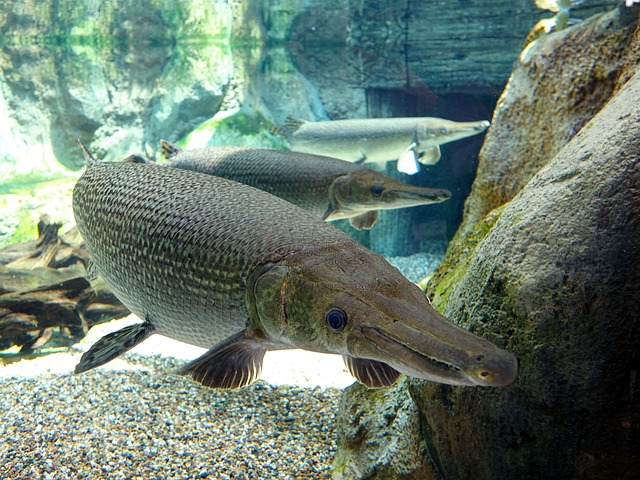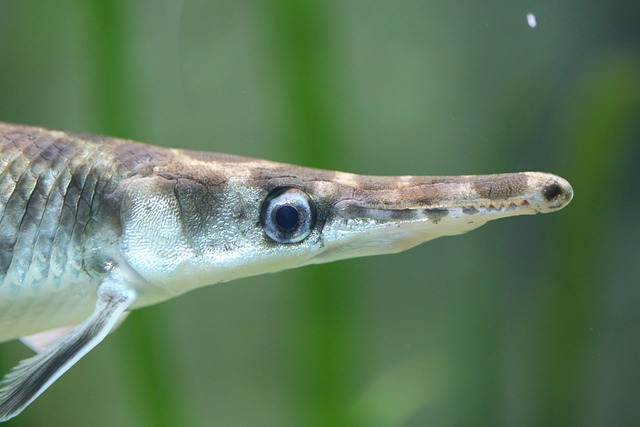Here are 50 facts about the gar
Ancient Fish: Gar fish are ancient fish that have been around for over 100 million years, coexisting with dinosaurs.
Scientific Name: The common gar fish belongs to the family Lepisosteidae, and the spotted gar is known as Lepisosteus oculatus.
Habitat: Gars are found in freshwater habitats such as rivers, lakes, swamps, and bayous in North and Central America.
Appearance: They have long, slender bodies covered in ganoid scales, which are tough, diamond-shaped scales that give them a prehistoric appearance.

Size: Gar species vary in size, with common gar typically reaching lengths of 2 to 3 feet (60 to 90 centimeters), and the alligator gar can grow much larger, reaching lengths of up to 10 feet (3 meters).
Longevity: Some gar species can live for several decades, with the potential to reach ages of 50 years or more.
Breathing Adaptations: Gars have a unique ability to breathe air using a modified swim bladder that acts as a lung. This allows them to survive in oxygen-poor waters.
Primitive Features: Gars possess primitive features, including their elongated bodies and jaw structures, which resemble those of their prehistoric ancestors.
Diet: They are carnivorous predators and feed on a diet of fish, crustaceans, and small animals. Their sharp teeth make them efficient hunters.
Hunting Behavior: Gars are ambush predators that wait for prey to come within striking distance before lunging forward to capture it.
Nocturnal Feeders: They are often more active at night when their prey is more active.
Spawning: Gar fish typically spawn in the spring. The females lay adhesive eggs on aquatic vegetation, and males guard the nest.
Solitary Behavior: Gars are usually solitary fish and are rarely found in large groups.
Locomotion: They are powerful swimmers and use their long bodies and tails to move swiftly through the water.
Weak Venom: While gars are often mistakenly thought to be venomous, their bite can be painful but is not toxic to humans.
Sensory Organs: Gars have well-developed sensory organs, including keen eyesight and a strong sense of smell.
Temperature Tolerance: Gars can tolerate a wide range of water temperatures and are adapted to both warm and cold waters.
Skin Respiration: Gars can extract oxygen through their skin, especially when oxygen levels in the water are low.
Noise Production: Gars are known to make grunting and croaking sounds, particularly during breeding activities.

Eggs and Young: Gar eggs are small and adhesive, sticking to aquatic vegetation. The young gars are vulnerable to predation in their early stages of life.
Prey Selection: They often target slower-moving or injured prey, making them important in controlling certain fish populations.
Hunting Techniques: Gars use a sit-and-wait hunting strategy, lurking in aquatic vegetation until prey comes close enough to strike.
Jaw Structure: Gars have a long and narrow snout filled with sharp teeth, ideal for capturing and holding onto prey.
Nictitating Membrane: Gars have a translucent, protective nictitating membrane that covers their eyes when hunting.
Predation: They face threats from larger fish, birds, and reptiles that prey on juvenile and smaller gars.
Range: Gars are native to North and Central America, with various species found in different regions.
Alligator Gar: The alligator gar is one of the largest gar species and can grow exceptionally large. It is found in the southern United States.
Florida Gar: The Florida gar is a smaller species found in the southeastern United States.
Spotted Gar: Spotted gar is known for its distinctive black spots and is found in parts of North America.
Conservation Concerns: Some gar species are threatened or endangered due to habitat loss and overfishing.
Sport Fishing: Gar fish are targeted by anglers in some areas for sport fishing.
Illegal Fishing: Overfishing and illegal fishing have posed significant challenges to gar conservation.
Economic Importance: Gars play a role in some local economies, particularly in the Southern United States, where they are sometimes caught for their meat and scales.
Aquarium Interest: Gars are occasionally kept in home aquariums, but their size and dietary needs make them challenging pets.
Mating Displays: During the breeding season, male gars may display aggressive behavior to attract females.
Size Variation: The size of gar fish can vary widely depending on the species and habitat.
Coloration: Common gar fish often have a light-colored belly and a dark green or brownish back.
Reproduction: Gars have internal fertilization, and females lay eggs that are fertilized by the male’s sperm.
Adaptation to Low Oxygen: Their ability to breathe air allows them to survive in waters with low oxygen levels.
Niche in Ecosystems: Gars occupy a unique ecological niche as apex predators in some freshwater ecosystems.
Temperature-Dependent Behavior: Their activity levels and feeding behavior can change with water temperature.
Defense Mechanisms: Gars are agile swimmers and can evade predators by darting into thick aquatic vegetation.
Ancient Lineage: Gars belong to an ancient lineage of fish, making them valuable subjects for evolutionary studies.
Prehistoric Relatives: Some of their prehistoric relatives, like the giant gar, were even larger and had more massive scales.
Commercial Harvesting: Gar fish have been commercially harvested in the past for their meat and scales.
Fossil Records: Fossils of ancient gar relatives have been discovered in various parts of the world.
Resilient Survivors: Gars have survived through significant geological and environmental changes over millions of years.
Artistic Inspiration: The distinctive appearance of gar fish has inspired artwork and sculptures.
Conservation Efforts: Conservationists work to protect gar populations and their habitats to ensure their long-term survival.
Ecological Role: Gars play a vital role in aquatic ecosystems by helping regulate fish populations and contributing to overall ecosystem health.
Gar fish are unique and ancient fish with fascinating adaptations and ecological importance in their freshwater habitats. While some species face conservation challenges, efforts are underway to protect these remarkable fish for future generations.
